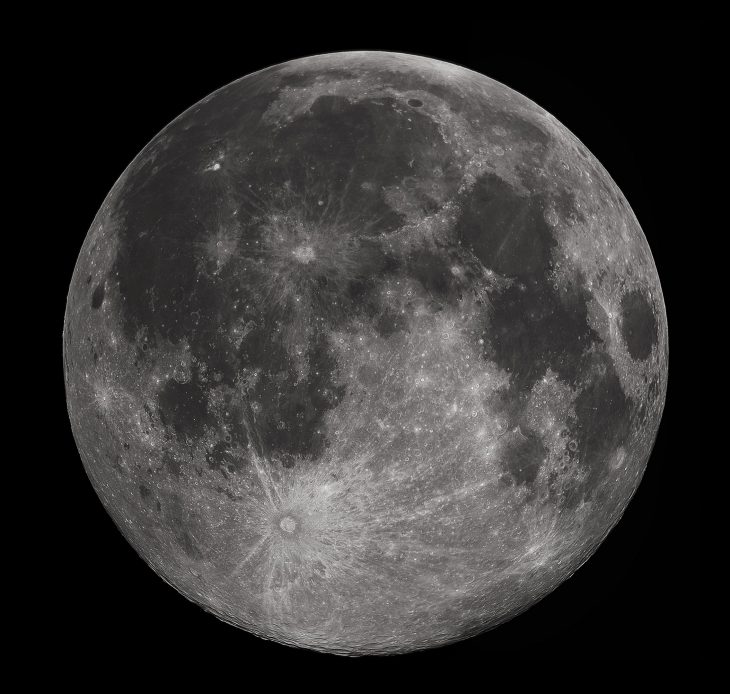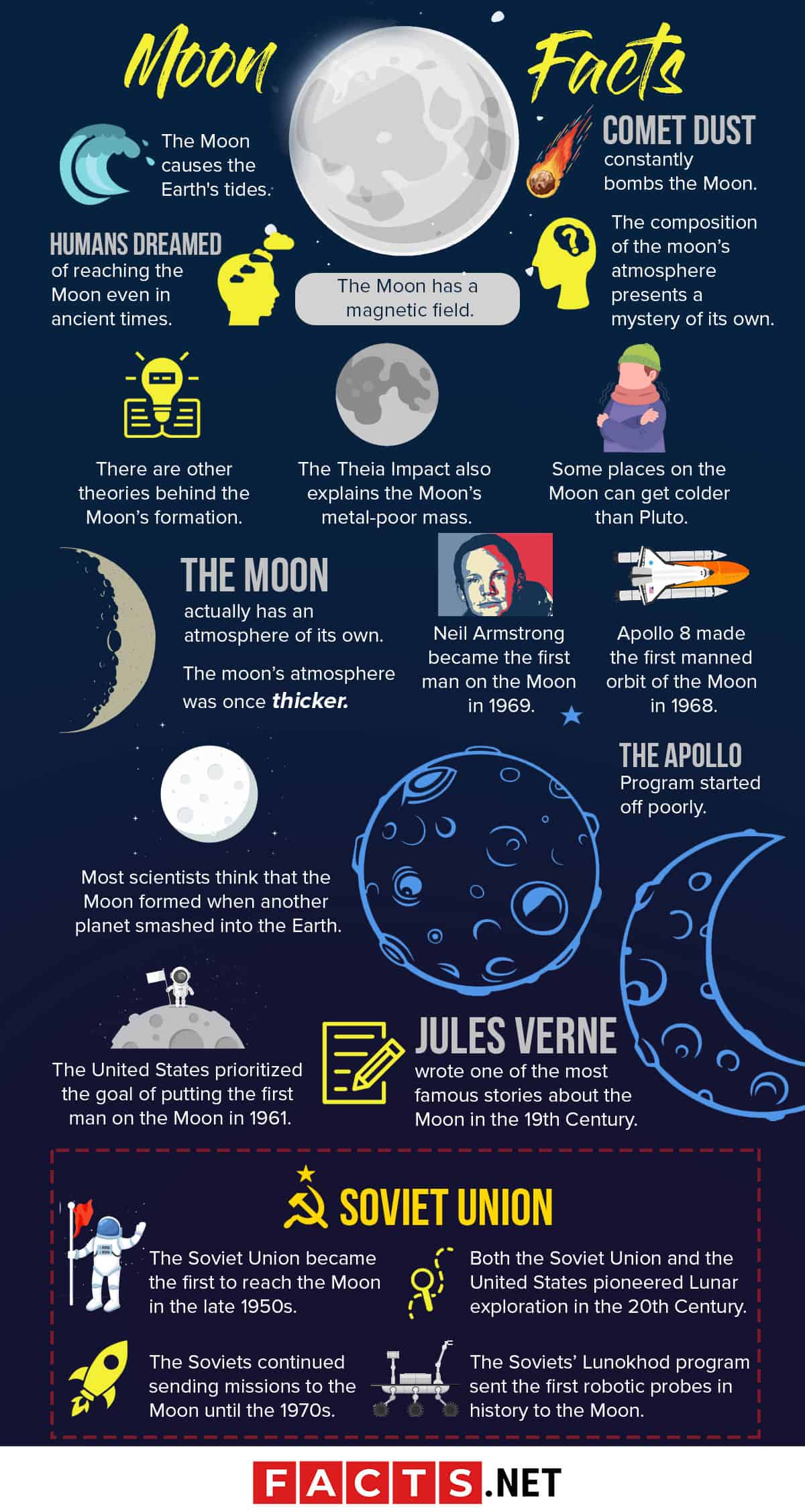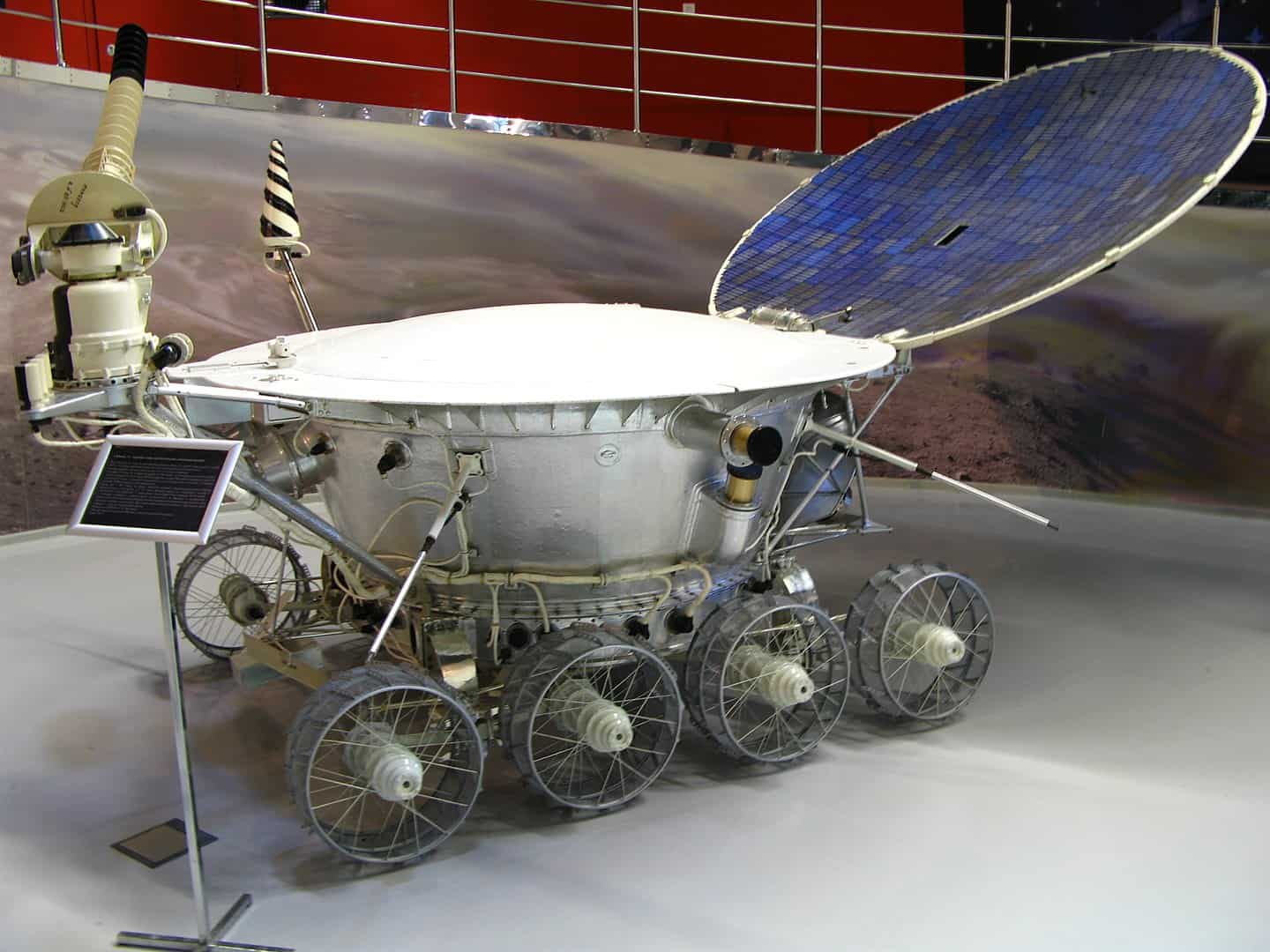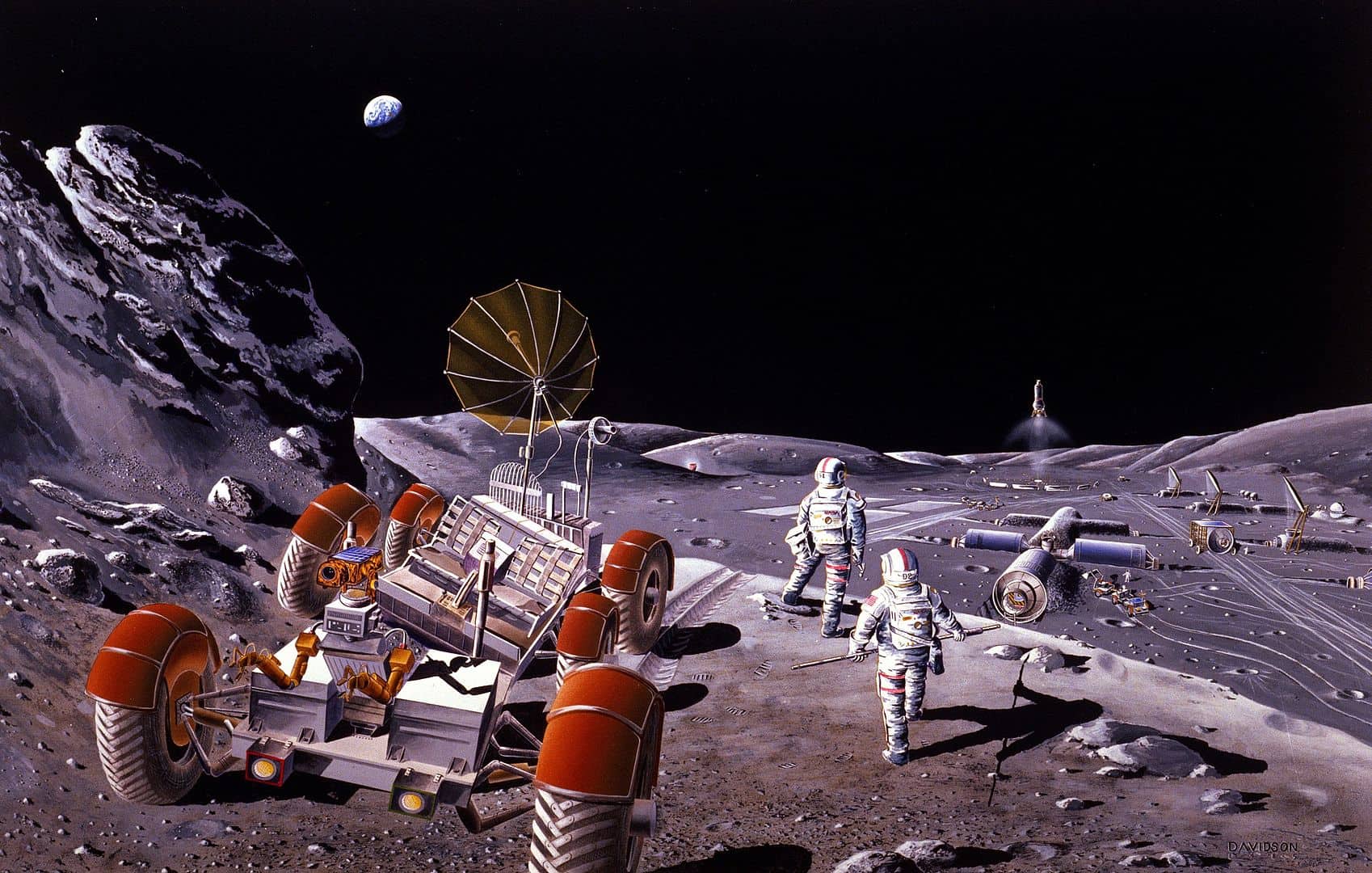
The Moon has always fascinated people whenever they look up at the night sky. As the Earth’s closest neighbor, the Moon has significantly helped us advance what we know about the universe. Next to our own planet, scientists have extensively studied the Moon. However, it still holds many mysteries despite how familiar it is at this point. Find out more about the space rock orbiting the Earth with these facts about the Moon.
- The Moon has a diameter of 3,474 km at its equator.
- At its poles, the Moon has an estimated diameter of 3,472 km.
- Scientists estimate its age at 4.53 billion years.
- The Lunar surface covers an area estimated at 3.79x107km².
- The Moon’s distance from Earth averages at around 384,402 km.
- The Babylonians made the first scientific studies of the Moon in the 5th Century BC.
- Anaxagoras first hypothesized that the Moon’s light came from reflected sunlight.
- Seleucus hypothesized that the Moon caused the tides in the 2nd Century BC.
- In that century, astronomers also roughly calculated the Moon’s distance from the Earth.
- Scholars in the Middle Ages largely agreed that the Moon was round.
- Galileo Galilei made the first telescopic observations of the Moon in the 17th Century.
- Giovanni Battista Riccioli and Francesco Maria Grimaldi invented the modern naming system for Lunar features in the late-17th Century.
- Wilhelm Beer and Johann Heinrich Mädler used trigonometry to accurately calculate the height of the Lunar mountains in the 19th Century.
- Also in that century, astronomers first theorized that volcanism didn’t make the Moon’s craters.
- Early 20th Century studies on the Moon later confirmed that theory as fact.
- The Moon’s crust measures 50 km thicker on its far side compared to its near side.
- Its iron core has an estimated thickness of 480 km.
- The Moon’s near side has over 300,000 craters with a width greater than 1 km.
- It takes the Moon 27.3 days to make one orbit around the Earth.
- The Moon orbits the Earth at a speed of 1.02 km/second.
Moon Facts Infographics

Most scientists think that the Moon formed when another planet smashed into the Earth.
One of the most interesting facts about the Moon is how it was formed. The most popular theory suggests that the Earth’s collision with an ancient planet named Theia created the Moon. According to this theory, Theia slammed into the Earth and caused molten rock to go flying into outer space, forming a cloud around the planet.
Over time, this cloud of molten rock cooled, clumping together into larger pieces, with the bigger pieces drawing smaller pieces to themselves with their gravity. Eventually, these pieces merged into a single object to form the Moon.
The Theia Impact also explains the Moon’s metal-poor mass.
Scientists believe that Theia’s collision with the Earth only scattered their outer surfaces, in an event also known as the Big Splash. Inside, their iron cores remained intact and eventually merged together, explaining why Earth has such a large iron core.
The leftover iron and metals from the debris cloud eventually formed the Moon’s core, but only in trace amounts. This, in turn, explains the low amount of metal in the Moon’s mass as well as its its relatively smaller size.
There are other theories behind the Moon’s formation.
Another theory claims that the ancient Earth spun so fast that molten rock literally went flying, eventually forming the Moon. However, scientists have dismissed this theory as prehistoric evidence shows no record of the Earth rotating fast enough to support the theory.
Another theory suggests that the Moon is actually a dwarf planet like Pluto, getting caught as a satellite after drifting too close to the Earth. Scientists also dismiss this theory, as it requires the ancient Earth to have a thicker atmosphere than evidence supports.
The Moon actually has an atmosphere of its own.
Before, people believed that the Moon didn’t have an atmosphere. However, scientists have since discovered the Moon’s very thin atmosphere. If you gather all the air on the Moon, it wouldn’t even reach a mass of 10 tons. To further compare, the air pressure on the Moon averages only 0.3 nPa, where Earth’s average air pressure is 101.33 kPa.
The composition of the moon’s atmosphere presents a mystery of its own.
Today, we know that moon’s atmosphere is made up of argon, helium, neon, sodium, polonium, potassium, and radon. However, scientists still debate why it doesn’t have oxygen and nitrogen like other atmospheres. Strangely enough, the moon’s crust has both of these elements along with magnesium, hydrogen, and carbon. Until now, scientists haven’t figured out why these elements are present on its surface, but not its atmosphere.

The Moon has a magnetic field.
One of the little-known facts about the Moon is that it has its own magnetic field. However, it’s very weak compared to the Earth. The Moon’s magnetic field measures less than 0.2 nT, whereas Earth’s magnetic field averages at 45,000 nT.
Amazingly, evidence collected from manned missions to the Moon shows that the ancient Moon had a magnetic field as strong as that of the Earth. Because of these findings, scientists believe that the Moon’s core cooled and solidified the field weakened, until it reached its current level.
The moon’s atmosphere was once thicker.
In 2017, NASA discovered that the ancient Moon’s atmosphere used to be much thicker. With frequent volcanic activity and a powerful magnetic field, the early Moon’s atmosphere had enough elements to bulk itself up. In time, the loss of volcanic activity and the weakening of the Moon’s magnetic field allowed the solar wind to strip the atmosphere away.
Comet dust constantly bombs the Moon.
On average, around 5 tons of cometary dust hit the Moon every single day. This, in turn, constantly keeps the Moon shrouded with a very thin cloud of dust. Scientists estimate its total mass at around 120 kg, rising up to 100 km above the Lunar surface.
Some places on the Moon can get colder than Pluto.
These places are usually found at the bottom of craters in the Moon’s polar regions. There, the craters’ depths and the Moon’s minimal tilt (only 1.54°) keep them constantly under shadow. In these craters, temperatures average at 30 Kelvin, whereas Pluto’s average temperature is 44 Kelvin. How’s that for a chilly facts about the Moon?
The Moon causes the Earth's tides.
As the Moon orbits the Earth, its gravity pulls at the planet. During this process, the Earth’s waters also gets pushed and pulled by the Moon. When they’re pulled away from the Earth’s landmasses, the oceans experience low tide. However, when the oceans get pushed towards the Earth, you have what’s called high tide.
Humans dreamed of reaching the Moon even in ancient times.
In the 2nd Century AD, the Roman author Lucian wrote the first-ever story set in outer space. Titled A True Story, the novel involved a group of travelers who managed to sail from the Earth into space, finding themselves caught in a war between the Sun and the Moon over the planet Venus. Modern critics consider the novel the first-ever science fiction work in history, while also falling into genres like satire and fantasy.

Jules Verne wrote one of the most famous stories about the Moon in the 19th Century.
French novelist Jules Verne published From the Earth to the Moon in France in 1865. The plot centers on building a cannon that would fire a shell to the Moon, with travelers sitting inside the shell for the journey. The story then followed the lengthy process which involved a lot of drama, even more so when actually building and then firing it.
In the end, the cannon was successfully built and fired, with the novel ending in a cliffhanger. Eventually, Verne describes the actual journey to the Moon and their return to Earth in the novel’s sequel, Around the Moon.
Both the Soviet Union and the United States pioneered Lunar exploration in the 20th Century.
While the Space Race had a scientific angle to it, the primary motive for both superpowers was to gain prestige to push their respective causes in the Cold War. There was also a military angle, with the possibility that Lunar exploration might allow the deployment of bases and troops on the Moon itself. Though both the Soviets and the Americans weren’t sure about the possibility, they didn’t want to allow their rivals to gain an edge if it actually became reality. Definitely one of the more political facts about the Moon.
The Soviet Union became the first to reach the Moon in the late 1950s.
In 1957, the Soviet Union launched the first artificial satellite, Sputnik. Prior to this feat, the Soviets actually launched 3 failed probes to the Moon in 1958. In these previous attempts, Luna 1 moved past the Moon, while Luna 2 actually landed on it. Finally, Luna 3 took the first photographs of the far side of the Moon.
The Soviets continued sending missions to the Moon until the 1970s.
All of these missions went unmanned, with Luna 10 making the first-ever orbit of the Moon in 1966. The Soviets also launched automated probes like Luna 16, 20, and 24, to collect rock and soil samples to bring back to Earth.
The Soviets’ Lunokhod program sent the first robotic probes in history to the Moon.
In 1970 and 1973, respectively, the Soviet Union launched Lunokhod 1 and 2. Both robots took pictures of the Lunar surface, studied cosmic and solar radiation levels, and even bounced lasers between Earth and the Moon. This laser experiment allowed scientists on Earth to precisely calculate the distance between the Earth and the Moon.

The United States prioritized the goal of putting the first man on the Moon in 1961.
Since the USA has fallen particularly behind the Soviet Union in the Space Race, the US fought to achieve an extraordinary feat. By this time, the Soviets had had already put the first man in space, sending Yuri Gagarin off on the Vostok 1 spacecraft.
In response, US President John F. Kennedy made a historic speech pledging the USA to put a man on the Moon before the decade’s end.
The Apollo Program started off poorly.
One of the sadder facts about the Moon is how many lives were claimed as humans tried to reach it. Despite its promise, the Apollo 1 mission ended up as a complete disaster, with a test of the spacecraft’s systems causing an electrical fire. The failure of the emergency release hatch along with the use of pure oxygen in its life support system resulted in the deaths of all 3 astronauts inside. This led to a major delay as Apollo was completely redesigned to prevent a repeat of the accident.
Apollo 8 made the first manned orbit of the Moon in 1968.
The Apollo 8 mission concluded long series of preparation to put a man on the Moon. Before this mission, preparations included the Ranger Program’s closeup pictures of the Moon, the Lunar Orbiter Program’s detailed maps, and the Surveyor probes’ landing experiences. Despite being an unmanned mission, Apollo 8 proved the ability of the spacecraft to reach and return from the Moon, opening the door to manned landings.
Neil Armstrong became the first man on the Moon in 1969.
Launched on July 16th, 1969, the Apollo 11 mission made its historic landing on July 20th. With the American flag in hand, Neil Armstrong became the first man on the Moon. This also made way for the historic remark, “One small step for man, and one giant leap for mankind.”
Around 500 million people watched the moment live on Earth, making it the largest audience for a TV broadcast at the time. This is definitely one of the more admirable facts about the Moon.

The USA continued sending astronauts to the Moon until 1972.
Launched on December 7th, 1972, Apollo 17 became the last manned mission to the Moon. The astronauts on the mission knew they were the last batch sent off to the Moon, but they promised that humanity would eventually return. Today, nearly 50 years after Apollo 17, that promise remains unkept. Definitely one of the more curious facts about the Moon.
Other countries have reached the Moon in the past decades.
In 2004, the European Space Agency (ESA) sent the SMART-1 into Lunar orbit, where it stayed until it crashed into the Moon in 2006. In 2007, China followed with Chang’e 1, and again with Chang’e 2 in 2010. Similarly, the Japanese Aerospace Exploration Agency (JAXA) also launched the Lunar probe Kaguya in 2007. For India, they reached the Moon with Chandrayaan 1 in 2008.
Non-Government Organizations (NGOs) have also expressed interest in reaching the Moon.
In 2008, Google partnered with the X Prize Foundation to encourage private attempts at reaching the Moon. With a deadline in March 2018, participants had to put a robotic probe on the Moon by that time. However, the deadline passed without any winners, as all 16 participants couldn’t make the date.
The US government also made a similar encouragement to private enterprises to reach for the Moon. They started with Moon Express in 2016, with the company granted official permission and support from the government to reach the Moon on a private basis.
NASA added its own encouragement for Moon expeditions in 2018.
To encourage more private businesses to engage in space discovery, NASA put up a competition for private companies. To win, they needed to develop and present a feasible concept for an economical way to send cargo to and from the Moon. In 2018, NASA Administrator Jim Bridenstine described the program as the first step to developing domestic and regular traffic to and from the Moon.
The Moon has a complicated legal status.
In 1967, the USA, Russia, China, and India all signed the Outer Space Treaty, which declared the Moon as the property of the human race as a whole. It also banned the building of military bases on the Moon or placing weapons of mass destruction (WMDs) on its surface. A few years later, 18 smaller nations also signed the Moon Agreement in 1979, which further banned commercial development of the Moon by any nation.
US President Donald Trump has denounced attempts to limit Lunar development.
In 2020, Trump described the Moon Agreement as something that limited and discouraged commercial development of the Moon as a whole. He also issued an executive order that encouraged any private enterprise to be involved with the Moon.

Astronomers are also very interested in further development of the Lunar surface.
The Moon’s extremely thin atmosphere and lack of human development would make any telescopes built on the Moon very accurate. In particular, the lack of light pollution and limited radio use makes building optical and radio telescopes on the Moon a very promising idea. The extreme cold of polar craters also offers scientists much promise as sites for future infrared telescopes. Definitely one of the more progressive facts about the Moon.
NASA plans to build bases on the Moon.
As of 2020, NASA plans to return to the Moon by 2024, aiming to build the first permanent settlement on the Moon by 2028. Even before that, the ESA supported a push by NGOs for a Moon Village, made up of a network of scientific, commercial, and educational facilities on the Moon from various nations and agencies. The ESA even described it as the logical next step after the completion of the International Space Station (ISS).
Plans for Lunar settlements involve both surface and underground construction.
Surface construction refers to short-term plans that will address the problems of future settlements’ radiation exposure and vulnerability to asteroid and comet impacts. In the long-term, underground construction solves both problems but is also more expensive and complex to build.

Economic expectations for settling the Moon focus on the long-term.
In the short-term, it’s unprofitable, thanks to the cost of getting to the Moon and building up a settlement. In the long-term, though, Lunar settlement would pay its costs back quickly once development finishes. Economic prospects include mining Lunar metals and minerals and sending it back to Earth. Scientists also see a large-scale possibility of mining Helium-3 on the Moon as fuel for next-generation nuclear fusion reactors.
Was this page helpful?
Our commitment to delivering trustworthy and engaging content is at the heart of what we do. Each fact on our site is contributed by real users like you, bringing a wealth of diverse insights and information. To ensure the highest standards of accuracy and reliability, our dedicated editors meticulously review each submission. This process guarantees that the facts we share are not only fascinating but also credible. Trust in our commitment to quality and authenticity as you explore and learn with us.
